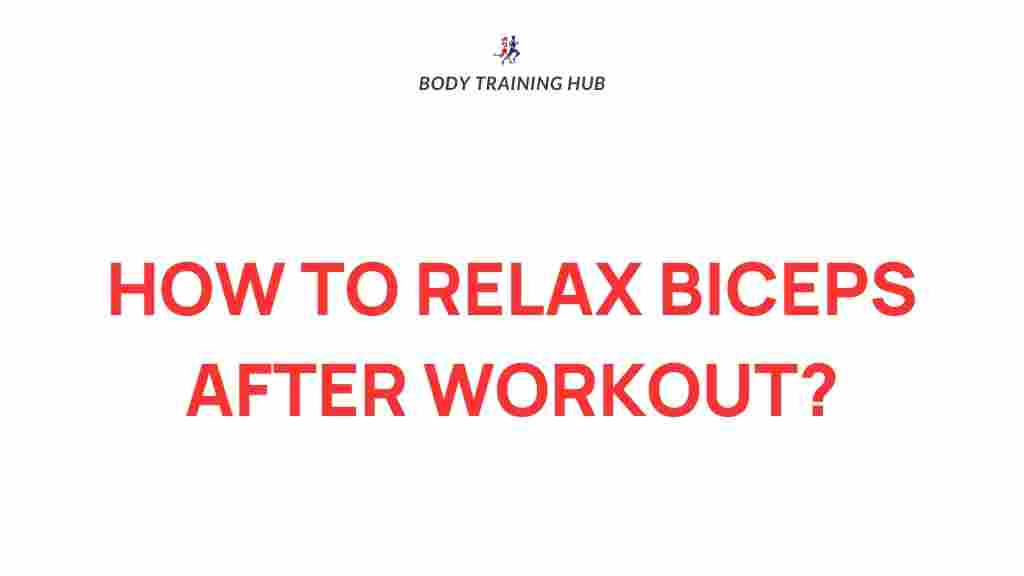Unlocking the Secrets of Muscle Recovery: Effective Ways to Relax Biceps Post-Workout
After an intense workout, your body needs time to recover, especially your biceps. Proper muscle recovery is essential for optimal performance, strength gains, and injury prevention. In this article, we will explore effective ways to relax your biceps post-workout, emphasizing relaxation techniques, recovery strategies, and the importance of fitness in muscle recovery.
The Importance of Muscle Recovery
Muscle recovery is a critical component of any fitness routine. After exercising, particularly during bicep workouts, your muscles undergo stress and micro-tears. This is a natural part of the muscle-building process, but it requires proper care to ensure effective recovery. Here are some key reasons why muscle recovery is essential:
- Reduces Muscle Soreness: Post-workout soreness, known as delayed onset muscle soreness (DOMS), can be alleviated through effective recovery techniques.
- Prevents Injury: Proper recovery helps to prevent overuse injuries and strains, especially in the biceps.
- Improves Performance: Allowing your muscles to recover aids in enhanced performance in future workouts.
- Promotes Muscle Growth: Recovery is where the actual muscle building occurs, as your body repairs and strengthens muscle fibers.
Effective Post-Workout Recovery Techniques for Biceps
Now that we understand the significance of muscle recovery, let’s dive into effective techniques to relax your biceps post-workout.
1. Hydration
Staying hydrated is crucial for muscle recovery. Water helps in nutrient transport and prevents fatigue. After a workout, make sure to:
- Drink plenty of water (at least 16-20 ounces after your workout).
- Consider electrolyte drinks if you’ve had an intense session.
2. Stretching
Gentle stretching can help relieve tension in the biceps and improve flexibility. Perform static stretches after your workout:
- Hold each stretch for 15-30 seconds.
- Focus on the bicep stretch: Extend your arm out, palm facing upward, and gently pull back the fingers with your opposite hand.
3. Foam Rolling
Foam rolling is a form of self-myofascial release that can help relieve muscle tightness. Here’s how to do it:
- Use a foam roller on your biceps and surrounding muscles.
- Roll slowly over tender spots and hold for 20-30 seconds.
4. Active Recovery
Engaging in light activities on your rest days can promote blood flow and aid muscle recovery. Consider:
- Going for a walk or light jog.
- Incorporating yoga or Pilates to improve flexibility and relaxation.
5. Nutrition
Your diet plays a vital role in muscle recovery. Focus on:
- Protein: Consume lean proteins like chicken, fish, or plant-based sources to aid muscle repair.
- Carbohydrates: Replenish your glycogen stores with complex carbs like whole grains and fruits.
- Healthy Fats: Include sources like avocados and nuts to support overall health.
6. Rest and Sleep
Quality sleep is one of the most effective recovery techniques. Aim for 7-9 hours of sleep per night. During sleep, your body repairs and grows muscle tissues.
7. Massage Therapy
Consider getting a professional massage or using a massage gun on your biceps. This can help reduce soreness and improve circulation.
Troubleshooting Common Post-Workout Issues
Sometimes, despite our best efforts, recovery can be challenging. Here are tips to troubleshoot common issues:
1. Persistent Soreness
If soreness lasts longer than a few days, consider:
- Reducing workout intensity or volume for a while.
- Incorporating more rest days into your routine.
2. Muscle Tightness
If you experience muscle tightness, try:
- Regularly incorporating flexibility exercises and stretches into your routine.
- Using heat therapy (like warm baths or heating pads) to promote relaxation.
3. Lack of Motivation
If you find yourself struggling to stay motivated for workouts, remind yourself of your fitness goals. Consider:
- Setting small, achievable goals.
- Finding a workout buddy for accountability.
Conclusion
In conclusion, muscle recovery is a crucial aspect of any fitness routine, especially after workouts targeting the biceps. By implementing effective recovery techniques such as hydration, stretching, foam rolling, nutrition, and adequate rest, you can enhance your muscle recovery and overall fitness. Remember, your body needs time to heal and adapt after exercise, so prioritize relaxation for optimal performance in future workouts.
For more information on effective exercise and recovery techniques, check out this resource. Also, don’t forget to explore our internal articles on fitness routines to keep your training diverse and engaging.
This article is in the category Strength & Recovery and created by BodyTraining Team
